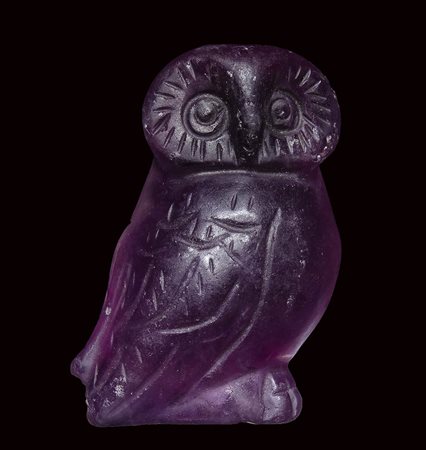 Bertolami Fine Art - Riversdell Close 27, KT16 9JW Chertsey
Bertolami Fine Art - Riversdell Close 27, KT16 9JW Chertsey
Auction 86 - Glyptics and Ancient Jewelry sessione unica
mercoledì 9 dicembre 2020 ore 14:00 (UTC +01:00)
A rare eastern greek fluorite carved idol. Owl.
A rare eastern greek fluorite carved idol. Owl.
4th - 3rd century B.C.
H: 48 mm
The tridimensional sculpture is depicting the famous owl of Athens or Athens noctua. The mythological animal is characterized by an horizontal elongated head with big rounded open-eyes. The head feathers and the pupils are deeply carved. The face is frontal meanwhile the body is turned to the left. The wings, and some other feathers are represented by the same carved-lines. The posture of the bird and the general appearance are referring to the mythological owl of the goddess Athena, symbol of the city of Athens (see coinage production). This sculpture can be seen as a votive idol or a very precious protective amulet empowered by the image linked to the goddess of wisdom and strategy. This ancient micro-sculpture is carved in an extraordinary deep purple bicolor fluorite.
The use of this mineral, from the eastern regions, is very ancient and can be also related to this function as Pline the Elder (H.N XXXVII). During the Antiquity, the amulets, sculpted figures and vessels productions in fluorite are attested in ancient Greece and Rome as a precious stone. Wellknown for the crystals wonderful colors and the perfect cleavage. According to current studies, fluorite is referrable to the ancient and precious Murra, used to produce cups and table vases. The oldest mention is from Sesto Properzio. The most complete description is by Caius Pliny the Second, who considers it a gem, although it was not considered as such, for example, by the jurist Cassio Longino around 50 A.D.
In the luxury of the Roman canteens, murrine were preferably used for hot drinks (Marco Valerio Marziale). Murra cups and vases were not lacking at the court of the Ptolemies (Gaio Svetonio Tranquillo). The first seems to have arrived in Rome with Pompey with the treasures of Mithridates. Pliny describes the particular aroma that this tableware emanated. The nature of murra is not yet well understood, Corsi, in 1845, hypothesizes it is a type of fluorite and C. E. N. Bromehead (1949) summarizes all the previous discussions, insisting on identifying murra with fluorite. Pliny describes “the murra vases come from the East. There they are found in several localities, not even famous, especially in the Parthian kingdom, but the most beautiful, however, are in Carmania. It is thought to be a liquid substance that solidifies under the ground by heat. […] Their splendor is without intensity and more than splendor it is properly luster. But what makes their value is the variety of colors, due to the repeated turning of the veins to purple red or pure white or a third shade between the two, when, as for a passage of color, the purple red becomes flaming or the milky white turns red. There are those who especially appreciate the edges and certain shades reissued, as seen in the inner part of the rainbow. Others like dense veins - any transparency or fading is a defect for them - as well as granules and spots that are not outgrowth, but, as also happens in the human body, mostly flat. Even the smell of the substance is a reason for value. The crystal is the result of a cause contrary to the one exposed, of a very intense solidification by freezing […]”.
See the Kantharos or Crawford Cup, British Museum, London, 1st-2nd A.D, found on the border between Syria and Turkey, or The Barber Cup, British Museum, London, 1st-2nd A.D, found on the border between Syria and Turkey (However, other research establishes that the “murra” should instead be identified with several specimens of banded agate and not with the fluorite).
This unique specimen is a beautiful exemple of the ancient craftsmanship from the choice of the bicolor fluorite and its artisitc treatment, combining both the stone and the mythic animal characteristics to emphasize the power of the symbolic hence the protective function of the sculpture. Wear marks. No missing parts. Extremely rare.
Enrico Butini Enigma dei vasi murrini. Leggende, storia, letteratura, indagine archeogemmologica. L'ERMA di BRETSCHNEIDER 2019; Dario Del Bufalo, Murrina Vasa: a luxury of imperial Rome, Roma 2016.
U.K. private colletion. Property of East London gentleman; formerly acquired by R. Ancient Art from Rabi Gallery (Mount street, London) in the 80's










